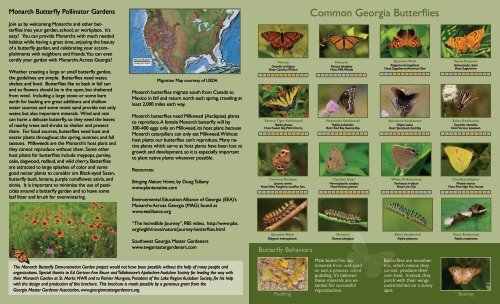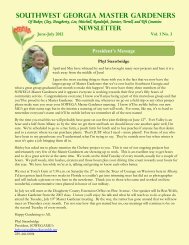Butterfly - Southwest Georgia Master Gardeners
Butterfly - Southwest Georgia Master Gardeners
Butterfly - Southwest Georgia Master Gardeners
Create successful ePaper yourself
Turn your PDF publications into a flip-book with our unique Google optimized e-Paper software.
Monarch <strong>Butterfly</strong> Pollinator Gardens<br />
Common <strong>Georgia</strong> Butterflies<br />
Join us by welcoming Monarchs and other butterflies<br />
into your garden, school, or workplace. It’s<br />
easy! You can provide Monarchs with much needed<br />
habitat while having a great time, enjoying the beauty<br />
of a butterfly garden, and celebrating your accomplishments<br />
with neighbors and friends. You can even<br />
certify your garden with Monarchs Across <strong>Georgia</strong>!<br />
Whether creating a large or small butterfly garden,<br />
the guidelines are simple. Butterflies need water,<br />
shelter, and food. Butterflies like to bask in full sun<br />
and so flowers should be in the open, but sheltered<br />
from wind. Including a large stone or some bare<br />
earth for basking are great additions and shallow<br />
water sources and some moist sand provide not only<br />
water, but also important minerals. Wind and rain<br />
can harm a delicate butterfly, so they need the leaves<br />
of nearby trees and shrubs to shelter and protect<br />
them. For food sources, butterflies need host and<br />
nectar plants throughout the spring, summer, and fall<br />
seasons. Milkweeds are the Monarch’s host plant and<br />
they cannot reproduce without them. Some other<br />
host plants for butterflies include maypops, parsley,<br />
oaks, dogwood, redbud, and wild cherry. Butterflies<br />
are attracted to large splashes of color and some<br />
good nectar plants to consider are Black-eyed Susan,<br />
butterfly bush, lantana, purple coneflower, salvia, and<br />
zinnia. It is important to minimize the use of pesticides<br />
around a butterfly garden and to leave some<br />
leaf litter and brush for overwintering.<br />
Migration Map courtesy of USDA<br />
Monarch butterflies migrate south from Canada to<br />
Mexico in fall and return north each spring, traveling at<br />
least 2,000 miles each way.<br />
Monarch butterflies need Milkweed (Asclepias) plants<br />
to reproduce. A female Monarch butterfly will lay<br />
300-400 eggs only on Milkweed, its host plant, because<br />
Monarch caterpillars can only eat Milkweed. Without<br />
host plants our butterflies can’t reproduce. Many native<br />
plants which serve as host plants have been lost to<br />
growth and development, so it is especially important<br />
to plant native plants whenever possible.<br />
Resources:<br />
Bringing Nature Home, by Doug Tallamy<br />
www.plantanative.com<br />
Environmental Education Alliance of <strong>Georgia</strong> (EEA)’s<br />
Monarchs Across <strong>Georgia</strong> (MAG) found at<br />
www.eealliance.org<br />
Viceroy<br />
Limenitis archippus<br />
Host: Carolina Willow<br />
J F M A M J J A S O N D<br />
Eastern Tiger Swallowtail<br />
Papilio glaucus<br />
Host: Sweet Bay, Wild Cherry<br />
Monarch<br />
Danaus plexippus<br />
Host: Milk Weeds<br />
J F M A M J J A S O N D<br />
Palamedes Swallowtail<br />
Papilio palamedes<br />
Host: Red Bay, Swamp Bay.<br />
J F M A M J J A S O N D J F M A M J J A S O N D<br />
Common Buckeye<br />
Junonia coenia<br />
Host: False Foxglove, toadflax fam.<br />
J F M A M J J A S O N D<br />
Carolina Satyr<br />
Hermeuptychia sosybius<br />
Host: Various grasses<br />
Question Mark<br />
Polygonia interrogationis<br />
Host: Sugarberry, American Elm<br />
J F M A M J J A S O N D<br />
Spicebush Swallowtail<br />
Papilio troilus<br />
Host: Spicebush, Red Bay<br />
J F M A M J J A S O N D<br />
White M Hairstreak<br />
Parrhasius m-album<br />
Host: Live Oak<br />
J F M A M J J A S O N D J F M A M J J A S O N D<br />
Tawny Emperor<br />
Asterocampa clyton<br />
Host: Sugarberry<br />
J F M A M J J A S O N D<br />
Zebra Swallowtail<br />
Eurytides marcellus<br />
Host: Various pawpaws<br />
J F M A M J J A S O N D<br />
Cloudless Sulphur<br />
Phoebis sennae<br />
Host: Partridge Pea, Sennas<br />
J F M A M J J A S O N D<br />
“The Incredible Journey”, PBS video, http://www.pbs.<br />
org/wgbh/nova/nature/journey-butterflies.html<br />
<strong>Southwest</strong> <strong>Georgia</strong> <strong>Master</strong> <strong>Gardeners</strong><br />
www.swgamastergardeners.com<br />
Question Mark<br />
Polygonia interrogationis<br />
<strong>Butterfly</strong> Behaviors<br />
Monarch<br />
Danaus plexippus<br />
Black Swallowtail<br />
Papilio polyxenes<br />
Giant Swallowtail<br />
Papilio cresphontes<br />
The Monarch <strong>Butterfly</strong> Demonstration Garden project would not have been possible without the help of many people and<br />
organizations. Special thanks to Ed Gartner. Ann Bruce and Tallahassee’s Apalachee Audubon Society for leading the way with<br />
their Monarch Garden at St. Marks NWR and to Reinier Munguia, President of the Lake Region Audubon Society, for his help<br />
with the design and production of this brochure. This brochure is made possible by a generous grant from the<br />
<strong>Georgia</strong> <strong>Master</strong> Gardener Association, www.georgiamastergardeners.org.<br />
Puddling<br />
Male butterflies sip<br />
minerals from wet sand<br />
or soil, a process called<br />
puddling. It’s believed<br />
these minerals are essential<br />
for successful<br />
reproduction.<br />
Butterflies are ectothermic,<br />
which means they<br />
cannot produce their<br />
own heat. Instead, they<br />
perch with their wings<br />
outstretched on a sunny<br />
spot.<br />
Basking





